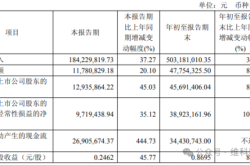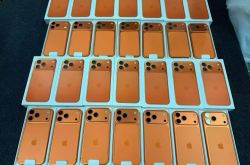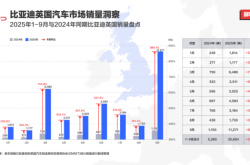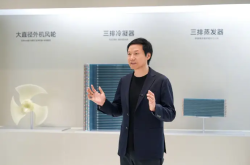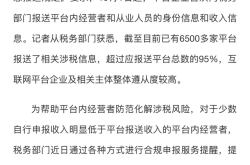Jen-Hsun Huang Unveils Multiple Technologies at NVIDIA's GTC Conference, Yet Stock Price Remains Stagnant
![]() 03/19 2025
03/19 2025
![]() 506
506
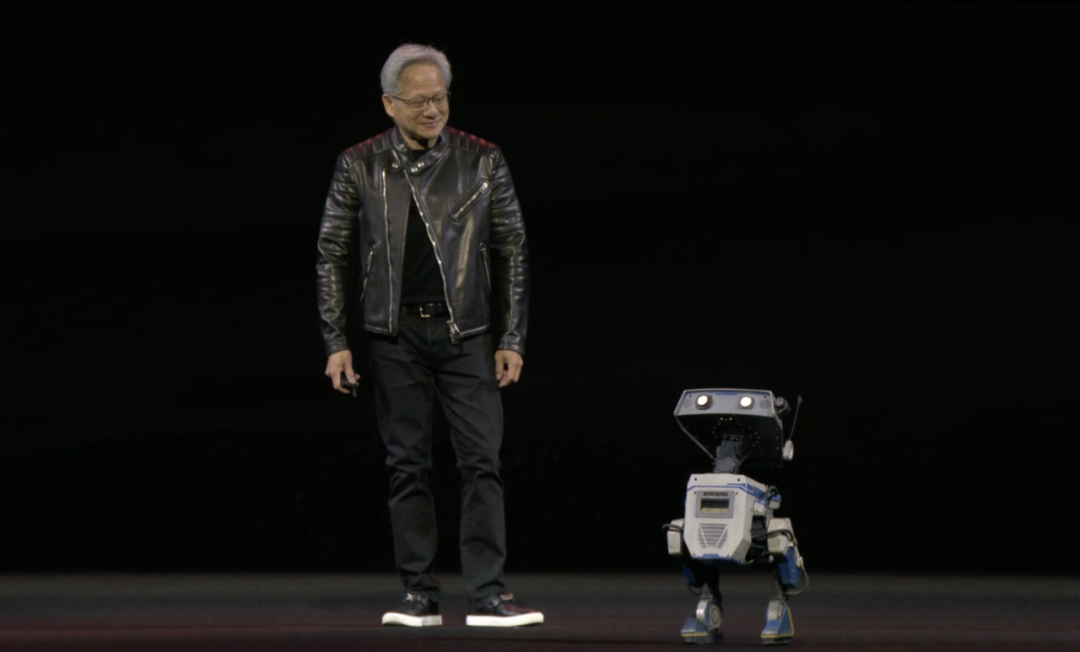
Edited by | Zhang Lianyi
NVIDIA's stock price has undergone significant fluctuations since 2025. Earlier this year, it peaked at $153.13 per share on January 7, but it has since declined, particularly after the launch of DeepSeeK R1 on January 20, which highlighted a low-cost, high-performance AI inference solution. Despite recent signs of recovery, the market capitalization has still dwindled by over $1 trillion from its record high.

Recent NVIDIA stock price trend
On March 18, local time, NVIDIA's annual GTC Conference, often referred to as the "AI Developer's Spring Festival Gala," took place as scheduled. CEO Jen-Hsun Huang delivered a keynote speech, amid high expectations that this event could serve as a turning point for U.S. tech stocks. Huang had previously hinted during the fiscal 2025 Q4 earnings call that "truly amazing products would be showcased at GTC."
However, despite Huang's announcements of several positive developments—including the full-scale production of the Grace Blackwell solution, with 3.6 million Blackwell GPUs shipped to four major platforms since 2025, the unveiling of performance parameters and launch timelines for the Vera Rubin AI superchip and Blackwell Ultra, the announcement of a deep collaboration with General Motors, the release of the NVIDIA Halos AI solution focused on automotive safety, and the open-source humanoid robot base model GROOT N1—NVIDIA's stock price failed to improve. By the close of trading on March 18, Eastern Time, NVIDIA's stock price had fallen to $115.59 per share, with a total market capitalization of $2.82 trillion.
01 Next-Generation AI Chip Vera Rubin Announced, to Launch in Second Half of 2026
As NVIDIA's core business, the data center segment remained the focus of attention at the conference, forming the highlight of Huang's speech and pushing the event to its climax.
"The Grace Blackwell solution has gone into full-scale production," Huang immediately shared good news regarding the data center business.
At last year's GTC Conference, Huang introduced the new-generation AI chip architecture, Blackwell. He emphasized that under the Blackwell architecture, chips could be interconnected to form large-scale AI supercomputing clusters, capable of supporting greater computational demands. "It is NVIDIA's most successful product."
Due to repeated delays in delivery, Huang has repeatedly emphasized in recent events that Blackwell chips have entered full-scale production, with 3.6 million GPUs shipped to four major platforms since 2025.
The Grace Blackwell series comprises multiple products, including GB200 and B200, all manufactured using a 4nm process and boasting up to 208 billion transistors.
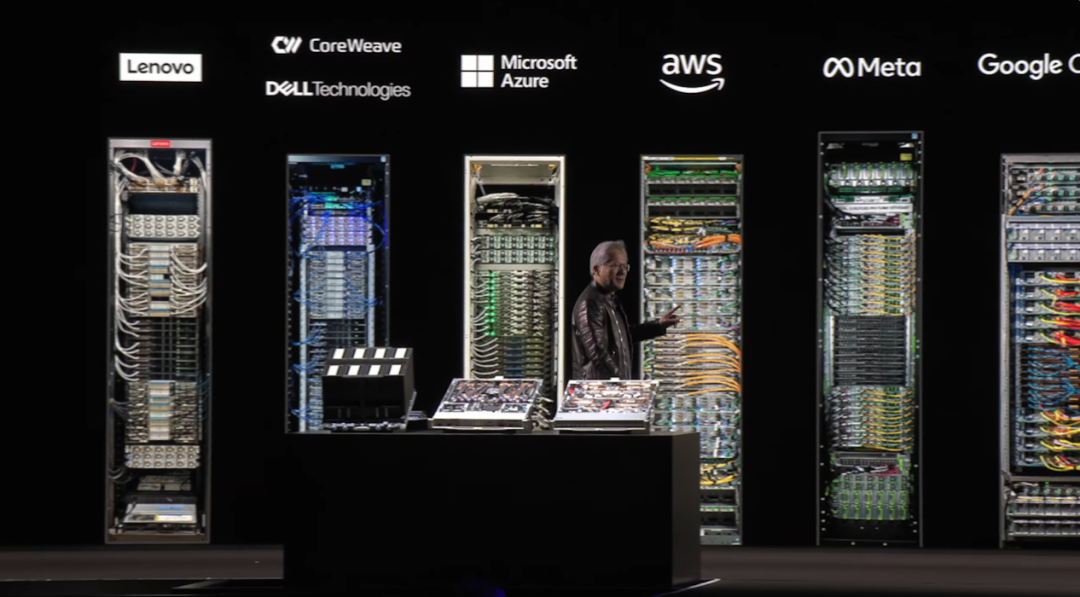
Jen-Hsun Huang showcasing the Blackwell data center
At the conference, Huang also showcased data center racks from various vendors utilizing Grace Blackwell, including customers such as Lenovo, Dell, Microsoft, Amazon, Meta, and Google.
He noted that data center construction is at a "turning point" and is expected to exceed $1 trillion by 2028.
After announcing the production progress of existing products, the most anticipated segment of the conference arrived: the unveiling of Blackwell Ultra and Vera Rubin.
Blackwell Ultra, set to launch in the second half of 2025, boasts enhanced AI capabilities, making its performance 1.5 times that of the original Blackwell. According to Huang, Blackwell Ultra is designed for the "era of AI inference" and can facilitate AI processing methods that mimic human thinking and conclusion-drawing.
Like Blackwell, Blackwell Ultra will be integrated into NVIDIA's large NVL72 rack server, which combines 72 GB300 superchips to enhance efficiency and maintainability. The Blackwell Ultra NVL72 platform will be available in the second half of 2025.

Blackwell performance parameters
"In inference models, Blackwell's performance is 40 times that of Hopper," Huang said. The four major cloud computing companies have deployed three times as many Blackwell chips as Hopper chips. Cloud providers can leverage Blackwell Ultra to offer high-end AI services for time-sensitive applications, potentially generating 50 times the revenue from this new chip compared to the Hopper generation launched in 2023.
Beyond Blackwell Ultra, an even bigger surprise was the debut of the Vera Rubin AI chip, representing NVIDIA's next platform.
Named after astronomer Vera Rubin, who made groundbreaking advancements in dark matter research, profoundly transforming human understanding of the universe, Vera Rubin continues NVIDIA's naming convention for each generation of GPU architectures.
Huang stated that NVIDIA will transition to Blackwell Ultra chips in the second half of the year, with Vera Rubin set to launch in the second half of 2026.

Vera Rubin BVL 144 will be available in the second half of 2026
Like Grace Blackwell, Vera Rubin combines a central processing unit (CPU) and a graphics processing unit (GPU). In Grace Blackwell chips, Grace is the CPU, and Blackwell is the GPU. In Vera Rubin chips, Vera is the CPU, and Rubin is the GPU.
Huang pointed out that Vera's memory will be 4.2 times that of Grace, with a memory bandwidth 2.4 times greater. Coupled with Vera's 88 CPU cores, the chip's overall performance will double that of its predecessor. The Rubin GPU will be equipped with 288GB of HBM4.
Furthermore, NVIDIA also announced the next-generation chip after Vera Rubin, named Vera Rubin Ultra, set to launch in the second half of 2027. Vera Rubin Ultra will combine the Vera CPU and Rubin Ultra chip, where each Rubin processor comprises two GPUs on a single chip, while Rubin Ultra features four GPUs.
Like Blackwell and Blackwell Ultra, Vera Rubin and Vera Rubin Ultra will be introduced in large server rack systems.

Rubin Ultra NVL576 will be available in the second half of 2027
The Vera Rubin server, named NVL144, contains a total of 144 GPUs, offering performance 3.3 times that of the GB300 NVL72. The Vera Rubin Ultra NVL576 is equipped with 576 Vera Ultra GPUs, providing 14 times the speed of the GB300 NVL72 powered by Blackwell Ultra.
However, it is unclear whether the lack of a physical demonstration contributed to the less intense response to the Vera Rubin unveiling compared to Blackwell.
02 Collaborating with General Motors, Aiming for $5 Billion Annual Revenue in Automotive Business
Beyond data centers, autonomous driving has emerged as a crucial business segment for NVIDIA in recent years.
According to NVIDIA's fiscal 2025 financial report, its automotive and robotics business generated only $1.7 billion in revenue for the full year of 2024, accounting for just 1.3% of total revenue and the smallest proportion among the four major categories. However, it recorded the highest growth rate, with a year-on-year increase of 103%.
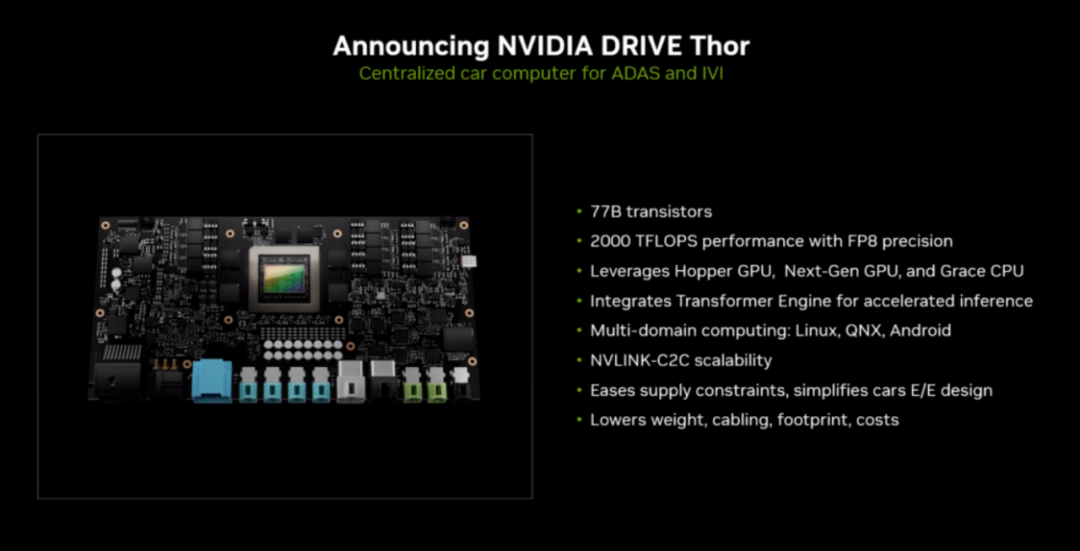
NVIDIA Thor announced in 2022
NVIDIA predicts that automotive vertical revenue will reach $5 billion this year, surpassing the sum of the past five years. This bold prediction is underpinned by significant confidence in the next-generation chip, Thor.
Released at the GTC Fall Conference in 2022, Thor is based on the Blackwell architecture, utilizes TSMC's 4nm process, and employs CoWoS-R packaging technology. It can process data from multiple sensors simultaneously, including cameras, radars, and LiDARs, enabling multimodal perception and decision-making.
In 2025, NVIDIA will primarily promote Thor-U and Thor-X, with single-chip computing power of 730 TOPS and 1050 TOPS, respectively. Thor-Z and Thor-S are expected to launch next year.
Benefiting from this, NVIDIA has secured numerous orders in the automotive sector since the beginning of this year.
At CES 2025, Huang announced that Toyota and NVIDIA would collaborate to build the next generation of autonomous vehicles. Toyota's next-generation models will be equipped with NVIDIA Orin chips and run the NVIDIA DriveOS operating system.
At this conference, Huang announced the latest progress in the automotive business: a collaboration with General Motors to jointly build its future autonomous driving fleet.
In Huang's view, the era of autonomous vehicles has arrived. NVIDIA will collaborate with General Motors in three areas, including AI for manufacturing, AI for enterprise workstyles, and AI for automobiles.
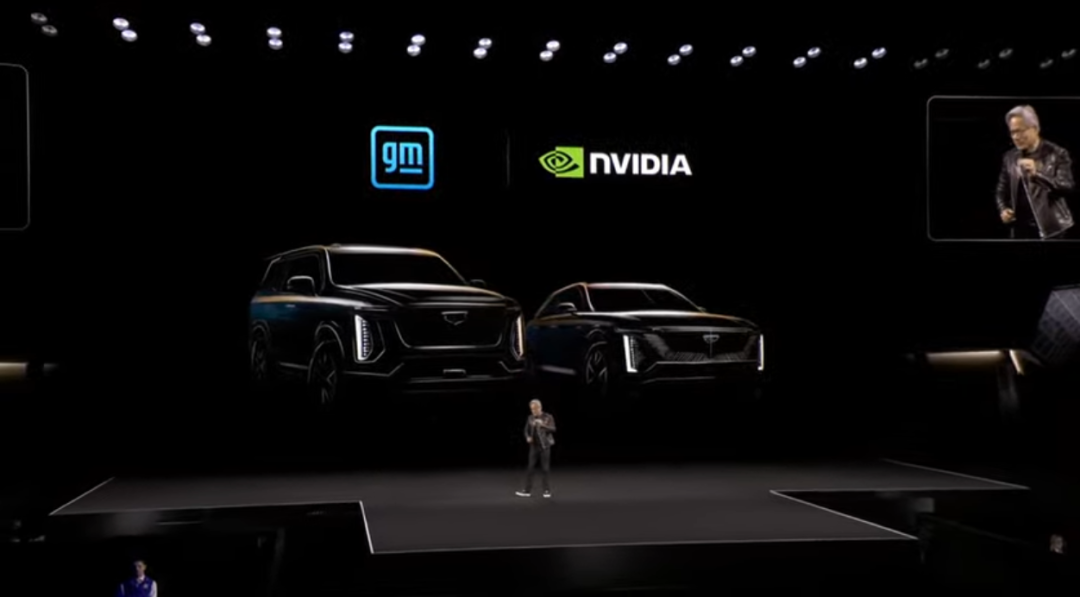
General Motors will collaborate with NVIDIA to build an autonomous driving fleet
Specifically, General Motors will utilize NVIDIA's DRIVE AGX hardware system as the onboard hardware for future advanced driver assistance systems and enhanced in-vehicle safety driving experiences. DRIVE AGX is an onboard platform designed by NVIDIA specifically for the development of production-level autonomous vehicles. It is a scalable and open platform that serves as the AI brain for autonomous vehicles.
Huang stated that the two companies will also collaborate to build customized AI systems using NVIDIA platforms such as NVIDIA Omniverse and NVIDIA Cosmos to train AI manufacturing models and optimize General Motors' factory planning and robotics. Omniverse is NVIDIA's proposed virtual world simulation engine, while Cosmos is NVIDIA's new generation of industrial simulation platform.
There are not only new collaborations but also new solutions.
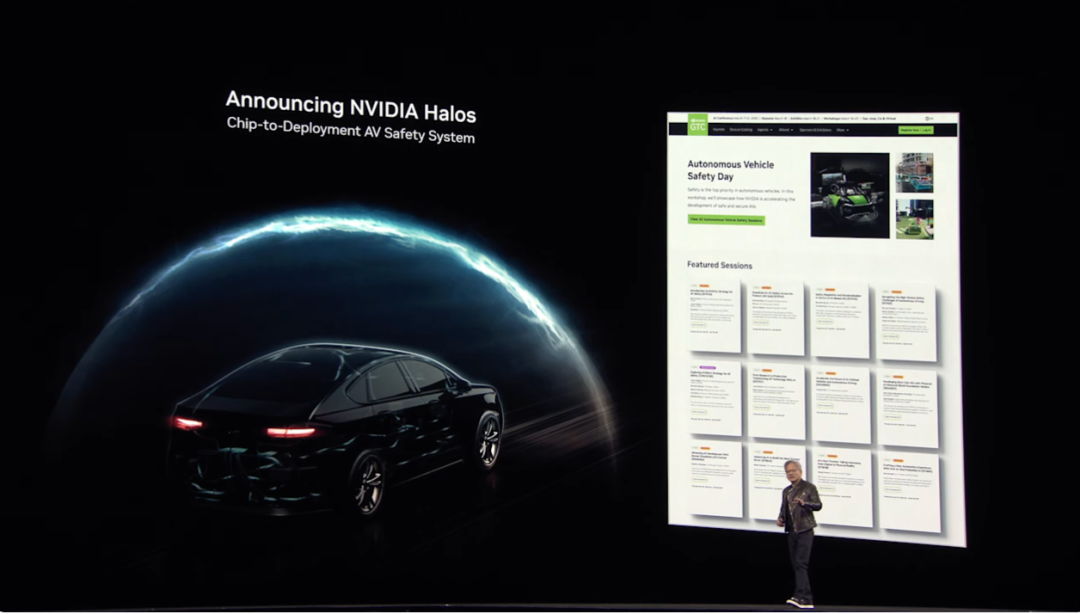
Jen-Hsun Huang announces the launch of NVIDIA Halos
At the conference, Huang announced the launch of NVIDIA Halos, an AI solution focused on automotive safety.
According to the introduction, Halos encompasses chips, software, tools, and services to ensure the safe development of AVs from the cloud to the vehicle, with a focus on an AI-based end-to-end AV stack. Huang said, "I believe we are the first company in the world to conduct security assessments on every line of code."
03 GROOT N1 Launched, Serving as a Functional Model for Open-Source Humanoid Robots
Another small climax of the conference was the introduction of robots.
Huang announced the open-source release of GROOT N1, the world's first humanoid robot base model. He stated that it is "the world's first open-source, fully customizable general-purpose humanoid inference and skills base model."
GROOT N1 is an evolved version of NVIDIA's Project Groot. At last year's GTC Conference, NVIDIA introduced Project Groot for industrial use cases. This time, GROOT N1 focuses on expanding to various humanoid robots of different shapes and sizes.
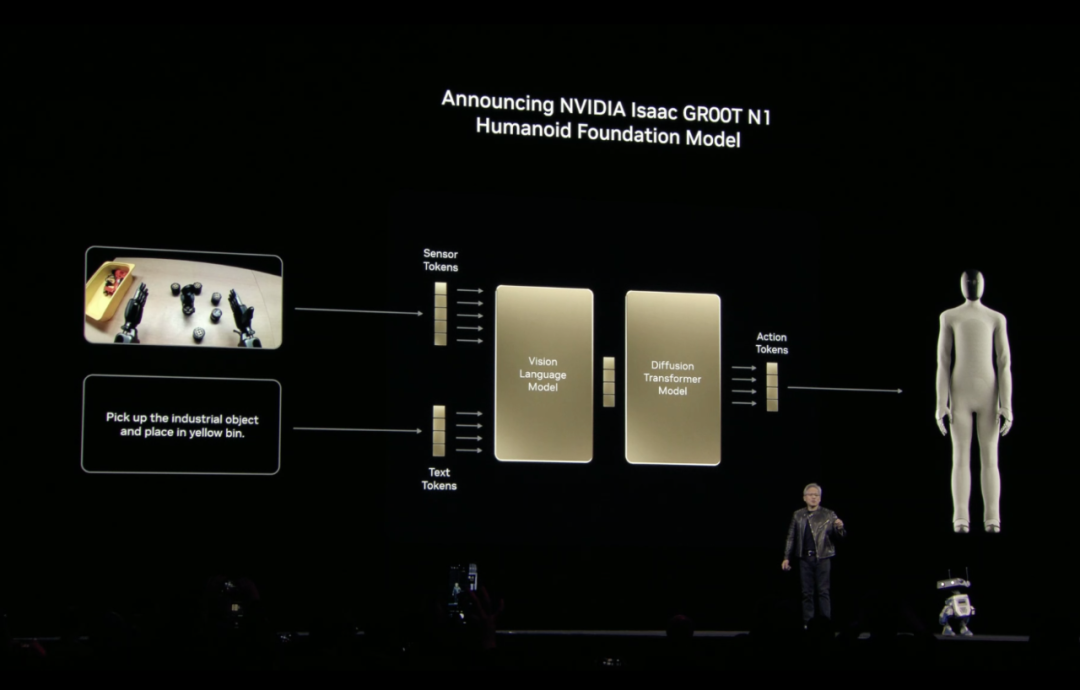
NVIDIA Open-Sources GROOT N1, a Basic Model for Humanoid Robots
Currently, GROOT N1 is already on the market and is the first in a series of fully customizable models that NVIDIA will pre-train and release to robot developers worldwide.
The GROOT N1 base model adopts a dual-system architecture inspired by human cognitive principles. "System 1" is a fast-thinking action model that reflects human reactions or intuitions, while "System 2" is a slow-thinking model used for deliberative decision-making. With the support of visual language models, "System 2" can reason about its environment and received instructions, planning actions that "System 1" then translates into movements. From the video, it can be seen that GROOT N1 can easily perform tasks such as grasping, transporting, and packaging.
In addition to this model, Huang also released a simulation framework and blueprint for generating synthetic training data. "At the same time, NVIDIA is collaborating with DeepMind and Disney Research to develop Newton, an open-source physics engine that allows robots to learn how to handle complex tasks more accurately."

NVIDIA Collaborates with DeepMind and Disney to Develop Newton
Built on the NVIDIA Warp framework, Newton will be optimized for robot learning and compatible with simulation frameworks such as Google DeepMind's MuJoCo and NVIDIA Isaac Lab. The three companies also plan to enable Newton to use Disney's physics engine.
"The era of robots has arrived. We clearly know that there is a severe shortage of the global workforce - a shortage of 50 million people." In Huang's view, our demand for robots is increasing daily.
From AI chips to cars and robots, Huang played multiple "big cards" at once, but judging from the stock price, it did not achieve the desired effect of quickly reviving market confidence.
After all, as Huang said, "The AI revolution has only just begun."
END-

